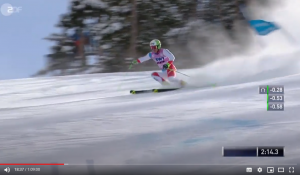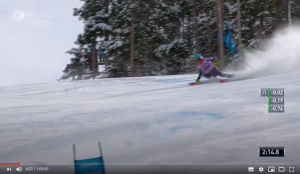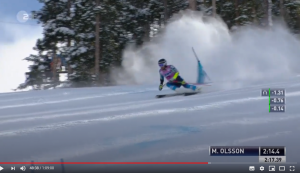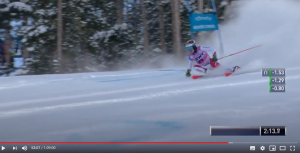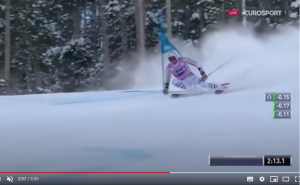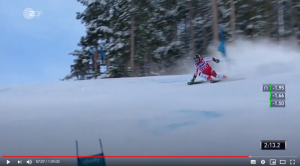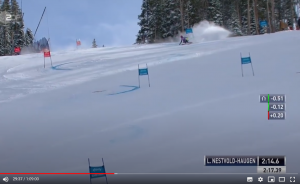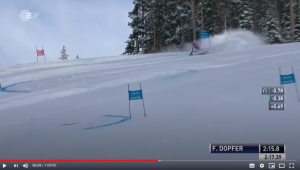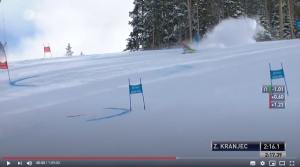I love to watch his knees in those super short turns on groomers (yes I know I"m repeating this). He lifts them up quickly and forcefully, creating an upward pulse. Serves him well in bumps.Reminding me of what an amazing, athletic bump skier Richie Berger is! Exclamation point the bottom of the turn!!!

-
For more information on how to avoid pop-up ads and still support SkiTalk click HERE.
You are using an out of date browser. It may not display this or other websites correctly.
You should upgrade or use an alternative browser.
You should upgrade or use an alternative browser.
How do you handle the bottom of the turn?
- Thread starter LiquidFeet
- Start date
There is a bottom half of the turn???? Silly me, I thought that was the start of the new turn....especially in slalom! 

Increasing the the distance between inside and outside by pushing the inside forward and/or outside backward.
^This basically. In turns with a lot of offset there is huge tip lead, in turns with little offset there is hardly any to no tip lead.
Lol, when I looked at this video of Hirscher I thought “His bottom is so early, I’m not sure there even is one“ & that is GS!There is a bottom half of the turn???? Silly me, I thought that was the start of the new turn....especially in slalom!
Well here we go. I'm going to keep it relatively short, cause I could go on for days about this topic.
There is research that shows the correlation between performance and ski binding position:
In a lot of cases a more forward position gave more performance, which is logical. By doing that the CoM moves forward, hence the radius becomes smaller, hence you need less time on the edges to achieve the same result, means more time on the base of the ski, equals more speed and faster times. Tip lead has the exact same effect.


Look at Luitz and Hirscher for example. Both have their CoM extremely far forward on the outside ski. In the paper I posted the difference in ski binding position was around 3% per turn. This is absolutely huge. Like I said, tip lead is exactly the same as moving the binding position, hence it can give you a couple of percent extra performance in a turn. The red line is where Hirschers CoM would have been without tip lead, the green line is where is CoM is now. This makes a very very big difference on how the ski will bend and react to the snow. There is a reason why the bottom of Hirscher's turn is so short, it's because he puts so much pressure down. Due to edge angle and due to where his CoM is. If you look at the inside leg shin angle, the ankle is not opened. In fact it is probably even more bent then when he would have equal tips. The tension in the tibia anterior only becomes bigger if you increase tip lead, and as you can see, big tip lead doesn't mean losing cuff contact or opening up the ankle on the inside. The outside ankle angle is extreme, at this point you are absolutely boot crushing on the outside ski. Without tip lead you can never be this forward on the outside ski. And even though I am using the term forward, Hirscher is still centered, his weight is in between his outside and inside ski. There is a difference between being forward and moving your CoM forward. This is a centered position with the CoM forward due to tip lead.

Top is me, below is Hirscher.
Now as to what being forward can mean.

Most people would say the skier that I marked as most forward is most back, which is not true. The skier I marked as most forward is most forward, cause his CoM is the most forward on the ski. His or her result on the snow will therefor be the best. The mistake people make is to look at what the ankles are doing, which is not relevant for how forward you are. How forward you are only means where is my CoM. The only thing ankle angles can tell you is balance. The Forward and Back position are the least balanced, the neutral one is balanced. Being forward or backward is not possible without using the boot for balance, if you are balance by skeletal support and using your own muscles, you are always neutral. Therefor the only way to move forward is by using tip lead. Cause then the weight is still in the middle, between your feet, and you can stand on the whole foot.
If you are arguing against tip lead, you are literally arguing against physics. Now as to the argument of moving the CoM backward on the inside and starting the next turn like that. That argument is invalid.


The reason the argument is invalid is because you only use tip lead if the turn is tight and you are going to flex anyway, cause you're going to be out of time. Which means you are going to move your CoM back anyways. Tip lead only means the inside ski is already where it is going to be in the transition. Apart from that you are not back, because you will be weightless during the transition, hence it doesn't matter where your CoM is. And if starting the turn back is such a problem, then why would you be against tip lead, but for flexing to release? Makes no sense. As you can see Luitz has tip lead and not even a second later he is in a flexed position. What he has done is release the pressure on the outside and the outside ski then accelerates forward. Hence the inside didn't move back, the outside moved forward by releasing pressure. The inside ski didn't move and due to tip lead it was already in the position it needed to be for the transition.
And no, this isn't flexing to release like most people think. That's another myth. You can't relax the outside leg before you raise your CoM and have your feet flat on the ground. If you relax the new inside leg while having lot of edge angle, you'll be flat on your face. A transition starts by raising the CoM from the core and hips. Only then the inside leg bends.
And as to big angles without tip lead, just look at the following pictures:




No tip lead, big angles. If you don't actively move forward on the outside and you are properly centered on your ski's, this is how it will look like. Moving your CoM that much forward is a choice, it's not something that will happen naturally. Just look at the amount of tip lead I've shown in this post of Hirscher and Luitz, that's intent. There is no way you'd end up there by accident.
There is research that shows the correlation between performance and ski binding position:
In a lot of cases a more forward position gave more performance, which is logical. By doing that the CoM moves forward, hence the radius becomes smaller, hence you need less time on the edges to achieve the same result, means more time on the base of the ski, equals more speed and faster times. Tip lead has the exact same effect.
Look at Luitz and Hirscher for example. Both have their CoM extremely far forward on the outside ski. In the paper I posted the difference in ski binding position was around 3% per turn. This is absolutely huge. Like I said, tip lead is exactly the same as moving the binding position, hence it can give you a couple of percent extra performance in a turn. The red line is where Hirschers CoM would have been without tip lead, the green line is where is CoM is now. This makes a very very big difference on how the ski will bend and react to the snow. There is a reason why the bottom of Hirscher's turn is so short, it's because he puts so much pressure down. Due to edge angle and due to where his CoM is. If you look at the inside leg shin angle, the ankle is not opened. In fact it is probably even more bent then when he would have equal tips. The tension in the tibia anterior only becomes bigger if you increase tip lead, and as you can see, big tip lead doesn't mean losing cuff contact or opening up the ankle on the inside. The outside ankle angle is extreme, at this point you are absolutely boot crushing on the outside ski. Without tip lead you can never be this forward on the outside ski. And even though I am using the term forward, Hirscher is still centered, his weight is in between his outside and inside ski. There is a difference between being forward and moving your CoM forward. This is a centered position with the CoM forward due to tip lead.
Top is me, below is Hirscher.
Now as to what being forward can mean.
Most people would say the skier that I marked as most forward is most back, which is not true. The skier I marked as most forward is most forward, cause his CoM is the most forward on the ski. His or her result on the snow will therefor be the best. The mistake people make is to look at what the ankles are doing, which is not relevant for how forward you are. How forward you are only means where is my CoM. The only thing ankle angles can tell you is balance. The Forward and Back position are the least balanced, the neutral one is balanced. Being forward or backward is not possible without using the boot for balance, if you are balance by skeletal support and using your own muscles, you are always neutral. Therefor the only way to move forward is by using tip lead. Cause then the weight is still in the middle, between your feet, and you can stand on the whole foot.
If you are arguing against tip lead, you are literally arguing against physics. Now as to the argument of moving the CoM backward on the inside and starting the next turn like that. That argument is invalid.
The reason the argument is invalid is because you only use tip lead if the turn is tight and you are going to flex anyway, cause you're going to be out of time. Which means you are going to move your CoM back anyways. Tip lead only means the inside ski is already where it is going to be in the transition. Apart from that you are not back, because you will be weightless during the transition, hence it doesn't matter where your CoM is. And if starting the turn back is such a problem, then why would you be against tip lead, but for flexing to release? Makes no sense. As you can see Luitz has tip lead and not even a second later he is in a flexed position. What he has done is release the pressure on the outside and the outside ski then accelerates forward. Hence the inside didn't move back, the outside moved forward by releasing pressure. The inside ski didn't move and due to tip lead it was already in the position it needed to be for the transition.
And no, this isn't flexing to release like most people think. That's another myth. You can't relax the outside leg before you raise your CoM and have your feet flat on the ground. If you relax the new inside leg while having lot of edge angle, you'll be flat on your face. A transition starts by raising the CoM from the core and hips. Only then the inside leg bends.
And as to big angles without tip lead, just look at the following pictures:
No tip lead, big angles. If you don't actively move forward on the outside and you are properly centered on your ski's, this is how it will look like. Moving your CoM that much forward is a choice, it's not something that will happen naturally. Just look at the amount of tip lead I've shown in this post of Hirscher and Luitz, that's intent. There is no way you'd end up there by accident.
Last edited:
In a lot of cases a more forward position gave more performance
Hang on a minute.... That is not what that paper states. The graph for the performance of 5 racers is this:
In this graph position A is the most forward and E is the most rearward. L and R bar charts are left and right turns respectively.
So racer 1 went better with bindings forward, racer 2 with them back, racer 3 went better further back on left leg and forward on right, racer 4 was better either back or neutral and racer 5 was better forward. So that's 2 who went better forward and 2 who went better back and one who was 50/50 depending on the leg.
That's hardly compelling evidence that forward is better which is why the paper's conclusions were:
So that means neither forward nor back binding positions are going to mean much that isn't specific to the skier and even to the specific leg of the specific skier.
In a lot of cases a more forward position gave more performance, which is logical. By doing that the CoM moves forward, hence the radius becomes smaller
50% of the legs went faster being back. How does that "logically" work?
@geepers
Yes very true, there can be various reasons as to why forward wasn't always better.
One of the reasons could be that they were too far forward, hence too much pressure on the ski, hence it slows them down. How much pressure you need is also dependent on the course set and the individual. If the course set is hard and turny, you are going to want a CoM that is more forward. Tip lead provides this. On an easier course you don't want this, cause then too much pressure slows you down.
Still doesn't explain individual differences in the same course set, but that could be due to anatomical differences, but also skill differences and timing differences. If you are able to bend a ski less, a more forward CoM helps. Could also be due to how a ski bends and how it is constructed. There is a lot of variables here.
However, if you accept the following hypotheses it is hard to argue against tip lead.
1. A ski bends more if the CoM is more forward.
2. Binding position has a significant impact on performance.
3. CoM position has an effect on performance and turning radius.
In that case when a course set becomes too tight to carve, tip lead will be beneficial, cause it will decrease turning radius and increase performance.
Yes very true, there can be various reasons as to why forward wasn't always better.
One of the reasons could be that they were too far forward, hence too much pressure on the ski, hence it slows them down. How much pressure you need is also dependent on the course set and the individual. If the course set is hard and turny, you are going to want a CoM that is more forward. Tip lead provides this. On an easier course you don't want this, cause then too much pressure slows you down.
Still doesn't explain individual differences in the same course set, but that could be due to anatomical differences, but also skill differences and timing differences. If you are able to bend a ski less, a more forward CoM helps. Could also be due to how a ski bends and how it is constructed. There is a lot of variables here.
However, if you accept the following hypotheses it is hard to argue against tip lead.
1. A ski bends more if the CoM is more forward.
2. Binding position has a significant impact on performance.
3. CoM position has an effect on performance and turning radius.
In that case when a course set becomes too tight to carve, tip lead will be beneficial, cause it will decrease turning radius and increase performance.
Last edited:
There is a saying up here, in Canada: "here, hold my beer"And no, this isn't flexing to release like most people think. That's another myth. You can't relax the outside leg before you raise your CoM and have your feet flat on the ground. If you relax the new inside leg while having lot of edge angle, you'll be flat on your face. A transition starts by raising the CoM from the core and hips. Only then the inside leg bends.

Look at these transitions, especially the third one.. You'll know it when you see it
Beers aside, I know where you're going - I don't think it's as much about raising com but about getting the required impulse from the previous turn. For instance on a really steep section, up impulse sends you into the net... there is a "default" and then there's tactics...
Last edited:
@Skitechniek Since you only linked the video Reilly had of Stefan Luitz's run, it is important to see what he actually wrote about tip lead:
Mike
The 3rd thing that ties into this whole movement pattern is the inside leg. As the outside leg stays long late into the turn the inside leg creeps very far forward and creates a huge tip lead. This type of tip lead is much greater than many other WC racers. Generally having your inside leg this far forward can open the ankle which makes it harder for pronation of the foot to happen and also as weight transfer starts the foot is also very far ahead of the COM. Not something I would personally coach because many people get caught behind and have to make a much larger re-centering move to get over the new outside leg, but, it seems to be working in his favor for this run.
You seem to be equating being forward with ski performance. Being forward tightens the radius of the turn by causing the ski to skid, not carve. Clearly, with some course sets, athletes cannot create sufficient edge angle to carve the turn in which cause they need to move forward to skid the ski and tighten the radius. But if the radius of the turns is equivalent, a carved ski will be faster than one that is skidding. Don't fool yourself that forward is always better than centered or, for that matter, being aft. They all have their place.Mike
I think he's talking about pulling the inside ski back during the turn, which will help being more centered at the beginning of next turn.@Skitechniek Since you only linked the video Reilly had of Stefan Luitz's run, it is important to see what he actually wrote about tip lead:
The 3rd thing that ties into this whole movement pattern is the inside leg. As the outside leg stays long late into the turn the inside leg creeps very far forward and creates a huge tip lead. This type of tip lead is much greater than many other WC racers. Generally having your inside leg this far forward can open the ankle which makes it harder for pronation of the foot to happen and also as weight transfer starts the foot is also very far ahead of the COM. Not something I would personally coach because many people get caught behind and have to make a much larger re-centering move to get over the new outside leg, but, it seems to be working in his favor for this run.You seem to be equating being forward with ski performance. Being forward tightens the radius of the turn by causing the ski to skid, not carve. Clearly, with some course sets, athletes cannot create sufficient edge angle to carve the turn in which cause they need to move forward to skid the ski and tighten the radius. But if the radius of the turns is equivalent, a carved ski will be faster than one that is skidding. Don't fool yourself that forward is always better than centered or, for that matter, being aft. They all have their place.
Mike
This will not tighten the turn radius, which is controlled by the outside ski
Nope, he is talking about skating the inside foot forward (e.g. increasing tip lead) and getting more forward on the outside ski...I think he's talking about pulling the inside ski back during the turn, which will help being more centered at the beginning of next turn.
This will not tighten the turn radius, which is controlled by the outside ski
Contrary to what the best skiers in the world, ie racers are doingNope, he is talking about skating the inside foot forward (e.g. increasing tip lead) and getting more forward on the outside ski...
@Mike King
I think @Rod9301 was referring to Reilly when Rod was talking about 'he'. And you were talking about me when you were talking about 'he'. Hence the miscommunication. Am I correct?
Reilly was talking about not letting the inside creep forward cause your CoM will be back while starting the next turn. And the other argument he made was about foot pronation.
To this post I've added 9 pics of the same turn of the same race. The pics are from Beaver Creek 2018. Here is the link to the race:
Go watch it yourself, frame by frame. I watch almost all races, and many I've watched frame by frame. Tip lead happens often in WC, they do it all the time when the course becomes hard (read turny). Go watch Adel Boden, or go watch Alta. See how they ski the steep and turny part on the Gran Risa. Most of them have massive tip lead. Hirscher definitely has. One of the few skiers who doesn't have a lot of tip lead is Ligety. Probably one of the reasons why he's not that good anymore.
I'm not saying forward is better. First of all those guys are centered, their weight is on the whole foot and their CoM is between their feet. They only have their CoM forward on the outside ski. And yes it does increase performance, if the definition of performance is a tighter radius turn. And no I do not mean skidded. If you move your CoM forward on the outside you don't start skidding all of a sudden.
What I mean is that tip lead is beneficial if turns are tight. It might be able to give you a couple percent of extra performance. On a whole course it might only make a couple of tenths difference, but to me those tenths matter. And you obviously only do this on the very turny parts. On the easier sections you don't see tip lead, cause the wc athletes in the clip can make the turn without it, so creating more resistance on the ski would only slow them down.
To the general folk this is probably nonsensical technical jibber jabber and I wouldn't see the point in teaching people in the ski school to actively increase tip lead. But since discussions are usually about high performance skiing, well here you go. High performance skiing has tip lead. The best in the world show this on a consistent basis. I literally picked 9 random racers, they all have huge tip lead in the same turn with huge offset.
Let's also distinguish fact from opinion for a moment:
Foot cannot pronate as easily when you are forward on the outside: Opinion
Your CoM relative to the inside ski is back if you have tip lead: Fact
If you move your CoM forward you start skidding: Opinion
If your CoM is more forward turning radius decreases: Fact
Apart from that, I already adressed why having your CoM back on the new outside ski is a nonsensical argument. If you are going to flex to release, your CoM is going to move backwards anyway. So who cares where your CoM is at the end of the turn? In high level racing you'll be weightless during the transition anyway, so cares where your CoM is at the end of a turn. The turn initation only starts after the transition. So this is the sequence of movements: Turn finish (with massive tip lead) --> transition (where you are moving your CoM back anyway if you flex to release, which doesn't matter, cause you'll be weightless) --> Turn initiation, here you need to be centered again. So I'm not going from the turn finish to turn initiation, the transition comes in between and during that transition the hips will move further back compared to the tip lead situation. So why would tip lead be a no no, but flex to release be a go go? Cause flex to release is what really messes with being centered if you can't create the forces to become weightless during transition.
I think @Rod9301 was referring to Reilly when Rod was talking about 'he'. And you were talking about me when you were talking about 'he'. Hence the miscommunication. Am I correct?
Reilly was talking about not letting the inside creep forward cause your CoM will be back while starting the next turn. And the other argument he made was about foot pronation.
To this post I've added 9 pics of the same turn of the same race. The pics are from Beaver Creek 2018. Here is the link to the race:
Go watch it yourself, frame by frame. I watch almost all races, and many I've watched frame by frame. Tip lead happens often in WC, they do it all the time when the course becomes hard (read turny). Go watch Adel Boden, or go watch Alta. See how they ski the steep and turny part on the Gran Risa. Most of them have massive tip lead. Hirscher definitely has. One of the few skiers who doesn't have a lot of tip lead is Ligety. Probably one of the reasons why he's not that good anymore.
I'm not saying forward is better. First of all those guys are centered, their weight is on the whole foot and their CoM is between their feet. They only have their CoM forward on the outside ski. And yes it does increase performance, if the definition of performance is a tighter radius turn. And no I do not mean skidded. If you move your CoM forward on the outside you don't start skidding all of a sudden.
What I mean is that tip lead is beneficial if turns are tight. It might be able to give you a couple percent of extra performance. On a whole course it might only make a couple of tenths difference, but to me those tenths matter. And you obviously only do this on the very turny parts. On the easier sections you don't see tip lead, cause the wc athletes in the clip can make the turn without it, so creating more resistance on the ski would only slow them down.
To the general folk this is probably nonsensical technical jibber jabber and I wouldn't see the point in teaching people in the ski school to actively increase tip lead. But since discussions are usually about high performance skiing, well here you go. High performance skiing has tip lead. The best in the world show this on a consistent basis. I literally picked 9 random racers, they all have huge tip lead in the same turn with huge offset.
Let's also distinguish fact from opinion for a moment:
Foot cannot pronate as easily when you are forward on the outside: Opinion
Your CoM relative to the inside ski is back if you have tip lead: Fact
If you move your CoM forward you start skidding: Opinion
If your CoM is more forward turning radius decreases: Fact
Apart from that, I already adressed why having your CoM back on the new outside ski is a nonsensical argument. If you are going to flex to release, your CoM is going to move backwards anyway. So who cares where your CoM is at the end of the turn? In high level racing you'll be weightless during the transition anyway, so cares where your CoM is at the end of a turn. The turn initation only starts after the transition. So this is the sequence of movements: Turn finish (with massive tip lead) --> transition (where you are moving your CoM back anyway if you flex to release, which doesn't matter, cause you'll be weightless) --> Turn initiation, here you need to be centered again. So I'm not going from the turn finish to turn initiation, the transition comes in between and during that transition the hips will move further back compared to the tip lead situation. So why would tip lead be a no no, but flex to release be a go go? Cause flex to release is what really messes with being centered if you can't create the forces to become weightless during transition.
Attachments
Last edited:
ST at that place in that turn, most are stepping off of it and focusing on transitioning on the new foot already - I would be curious to see examples at the top of the turn or in SL somewhere other than when the turning is over.
@razie
Each and everyone of them still has pressure on the outside. Sure, some are stepping off already, but they moved forward when there was pressure on the ski. Moving forward starts at the fall line already. It's not like the pressure was gone and then they ended up having tip lead all of a sudden...

Before the fall line...
Actively moving forward usually starts at the fall line though, rarely happens before. But tip lead is often times already present before the fall line. But actively moving forward at the fall line is about making the bottom of the turn tight and coming of the pressure as soon as possible. I wouldn't do it earier tbh, doesn't do much before the fall line. Your radius before the fall line in GS e.g. will be around 50 anyway. From the fall line onwards it will probably be closer to 10. That's where you can make the difference. Before the fall line you want to pick up that extra speed.
In slalom it doesn't happen as much either, But it does happen:

And another one:


Go analyse races yourself, I've done too much work for you already
Each and everyone of them still has pressure on the outside. Sure, some are stepping off already, but they moved forward when there was pressure on the ski. Moving forward starts at the fall line already. It's not like the pressure was gone and then they ended up having tip lead all of a sudden...
Before the fall line...
Actively moving forward usually starts at the fall line though, rarely happens before. But tip lead is often times already present before the fall line. But actively moving forward at the fall line is about making the bottom of the turn tight and coming of the pressure as soon as possible. I wouldn't do it earier tbh, doesn't do much before the fall line. Your radius before the fall line in GS e.g. will be around 50 anyway. From the fall line onwards it will probably be closer to 10. That's where you can make the difference. Before the fall line you want to pick up that extra speed.
In slalom it doesn't happen as much either, But it does happen:
And another one:
Go analyse races yourself, I've done too much work for you already
Last edited:
I have - see post just before yours 
But so let me get this strait - you are saying that all good racers let the inside ski shuffle ahead uncontrollably in most turns? Or push it forward on purpose?
But so let me get this strait - you are saying that all good racers let the inside ski shuffle ahead uncontrollably in most turns? Or push it forward on purpose?
Last edited:
@razie
Your radius before the fall line in GS e.g. will be around 50 anyway. From the fall line onwards it will probably be closer to 10. That's where you can make the difference. Before the fall line you want to pick up that extra speed.
In slalom it doesn't happen as much either, But it does happen:
The second proves my point really
Your first point, I think dots the I, however. To change the radius so much, you need a) a very well engaged ski and b) big angles at the point where big pressure appears and c) not be back! Once your there, with everything in check, the thing takes one blink after which you let it go...
That is exactly why they would normally not dare letting it go and let it shuffle before the fall line - if you get there back on the ski, your radius stays in the high double digits
What you're seeing there after the fall line is the afterglow of the big bang, when the ski turned quickly and now they're bending the boot so much and its coming back underneath, that it is nuts to continue staying that far forward and they're letting it go . Look back at your photos before my post and all of them have a super bent outside boot. Get any more forward and bend it anymore than that results in breaking the boot (done that) or the Achilles tendon, assuming you DIN is decent, at the very least you're jamming the turn and unable to release. You don't want to get forward at that point, you want to let it go , the opposite
At that point, a Canadian FIS coach might say "get direction", a US FIS coach might say "move" etc - it's a different thing and movement to do. Hey - what would European coaches say to do at that point? What would be the most common cue? I think you'd know that? Honest curiosity...
Last edited:
You are citing items as "fact" or "opinion;" do you have any support for your characterizations?...
Let's also distinguish fact from opinion for a moment:
Foot cannot pronate as easily when you are forward on the outside: Opinion
Your CoM relative to the inside ski is back if you have tip lead: Fact
If you move your CoM forward you start skidding: Opinion
If your CoM is more forward turning radius decreases: Fact
Apart from that, I already adressed why having your CoM back on the new outside ski is a nonsensical argument. If you are going to flex to release, your CoM is going to move backwards anyway. So who cares where your CoM is at the end of the turn? In high level racing you'll be weightless during the transition anyway, so cares where your CoM is at the end of a turn. The turn initation only starts after the transition. So this is the sequence of movements: Turn finish (with massive tip lead) --> transition (where you are moving your CoM back anyway if you flex to release, which doesn't matter, cause you'll be weightless) --> Turn initiation, here you need to be centered again. So I'm not going from the turn finish to turn initiation, the transition comes in between and during that transition the hips will move further back compared to the tip lead situation. So why would tip lead be a no no, but flex to release be a go go? Cause flex to release is what really messes with being centered if you can't create the forces to become weightless during transition.
WRT "forward," there's a difference between "moving forward" and where the CoM is wrt to base of support. Moving forward can still have the CoM behind the BoS, in the center, or in front of the BoS. The physics of the matter are that if the CoM is an iota in front of the center of the BoS, you create torque. And torque causes the ski to skid -- that is, the tails will take a wider path than the tips. For support, see "A Ski Instructors Guide to the Physics and Biomechanics of Skiing," Juris Vagners, Ph.D. and the PSIA Education Steering Committee, PSIA, 1995.
Sponsor
Staff online
-
Jim KenneyTravel Correspondent
-
dbostedoAsst. Gathermeister
-
DwightPractitioner of skiing, solid and liquid
Members online
- tromano
- Vinnie
- mike_m
- davjr96
- SpeedyKevin
- Jeffdag
- Jersey Skier
- BLiP
- ctsnowplow
- doc
- Atomicman
- tomahawkins
- Jim Kenney
- z57
- jdwalk
- Nomax
- Truberski
- JWMN
- dbostedo
- connersw
- Paul Black
- Chris V.
- Dwight
- BlueSky
- precisionchiro
- Stev
- Don in Morrison
- MOMENTinTime
- sparty
- butleri
- socalgal
- altabrig
- Jack skis
- LuliTheYounger
- Even_Stevens
- BigSlick
- cosmoliu
- nay
- my07mcx2
- NE1
- Jamt
- wnyskier
- Scruffy
- BeiJiHu
- evr66
- Wasatchman
- GB_Ski
- GregK
- Jwrags
- Ilyiadus
Total: 3,599 (members: 161, guests: 2,530,robots: 908)
